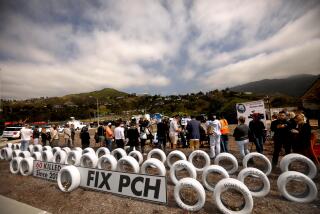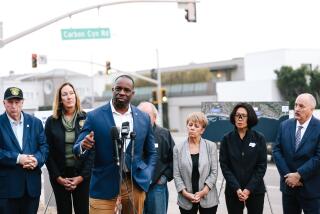Dear Street Smart:Recently I heard that the...
- Share via
Dear Street Smart:
Recently I heard that the California Highway Patrol said a large majority of drivers do not buckle up. I believe they based this on the fact that if a person gets thrown out of a vehicle, chances are that the person was not wearing a seat belt.
But is this always the case?
I could swear that I recall a lawsuit being filed by the parents of a girl who was thrown out of her vehicle. They believed that the seat belts on the car were faulty and failed to hold their daughter in the seat.
If this is true, how many people who do wear seat belts are still in risk of being thrown from their cars?
Vincent White, Lancaster
Dear Reader:
Although wearing a seat belt is no guarantee against serious injury or even death, not wearing one can be downright foolish. For every story of someone being thrown clear of a crash because they were not wearing a seat belt there are countless stories of seat belts saving lives.
As for drivers wearing seat belts, the number has steadily gone up since 1986, when California made them mandatory. In 1985, just 26% of drivers wore belts. In 1983, fully 83% did.
Officer Rich Obregon of the California Highway Patrol said seat belts make a difference. In 1986, the number of people killed per 100 million vehicle miles traveled in the state was 2.5. By 1993, the figure had dropped to 1.56, despite the fact that the number of cars on the road increased by nearly 3 million.
Put another way, Obregon said the CHP estimates that of the 1,049 unbelted drivers who died in 1994 on state-patrolled roads, 757 could have been saved if they had buckled up. That’s 72%.
“That’s amazing,” Obregon said.
The main purpose of seat belts is twofold. In addition to preventing passengers from being thrown out of the car, belts keep passengers from being thrown around inside the car.
And with the invention of air bags, seat belts become even more important. Unless someone is strapped in place, the force of a crash may knock them out of the way of the air bag as it inflates, rendering it useless.
It is almost impossible to determine how many people who regularly wear seat belts are in danger of being thrown from their car in an accident. Defective belts often do not make themselves known until it is too late.
Obregon and others suggest that seat belts should be replaced after even moderate accidents because the locking mechanism can break, making the belts less effective. “The cost is relatively minor when you figure you could be saving a life,” Obregon said.
More to Read
Sign up for Essential California
The most important California stories and recommendations in your inbox every morning.
You may occasionally receive promotional content from the Los Angeles Times.













